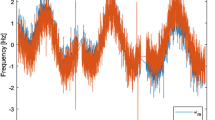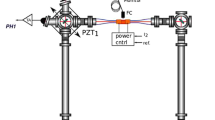Abstract
The study of local deformations is a hot topic in geodesy. Local rotations of the crust around the vertical axis can be caused by deformations. In the Gran Sasso area, the ring laser gyroscope GINGERINO and the GNSS array are operative. One year of data of GINGERINO is compared with the ones from the GNSS stations, homogeneously selected around the position of GINGERINO, aiming at looking for rotational signals with period of days common to both systems. At that purpose the rotational component of the area circumscribed by the GNSS stations has been evaluated and compared with the GINGERINO data. The coherences between the signals show structures that even exceed 60% coherence over the 6–60 days period; this unprecedented analysis is validated by two different methods that evaluate the local rotation using the GNSS stations. The analysis reveals that the shared rotational signal’s amplitude in both instruments is approximately 10−13 rad/s, an order of magnitude lower than the amplitudes of the signals examined. The comparison of the ring laser data with GNSS antennas provides evidence of the validity of the ring laser data for very low frequency investigation, essential for fundamental physics test.












Similar content being viewed by others
Data Availability Statement
This manuscript has associated data in a data repository. [Authors’ comment: Data sets generated during the current study are available from the corresponding author upon request].
Notes
rand generates uniformly distributed random numbers in the interval [0, 1), but the same result is achieved by using the randn function, which a instead generates random numbers distributed according to a standard normal distribution.
References
A.D.V. Di Virgilio, et al., to be published in MEMOCS (2023), arXiv:2209.09328
J. Belfi et al., Rev. Sci. Instrum. 88, 034502 (2017). arXiv:1702.02789
C. Kreemer, G. Blewitt, E. Klein, Geochem. Geophys. Geosyst. 15, 3849–3889 (2014). https://doi.org/10.1002/2014GC005407
Z. Altamimi, P. Rebischung, X. Collilieux, L. Métivier, K. Chanard, J. Geod. 97, 47 (2023). https://doi.org/10.1007/s00190-023-01738-w
T. Okazaki, Y. Fukahata, T. Nishimura, Earth Planets Space 73, 153 (2021). https://doi.org/10.1186/s40623-021-01474-5
E. Serpelloni, A. Cavaliere, L. Martelli, F. Pintori, L. Anderlini, A. Borghi, D. Randazzo, S. Bruni, R. Devoti, P. Perfetti et al., Front. Earth Sci. 10, 907897 (2022). https://doi.org/10.3389/feart.2022.907897
M. Palano, S. Calcaterra, P. Gambino, B. Porfidia, F. Sparacino, Results Geophys. Sci. 14, 100056 (2023). https://doi.org/10.1016/j.ringps.2023.100056
G. Leone, N. D’Agostino, L. Esposito, F. Fiorillo, Environ. Earth Sci. 82, 240 (2023). https://doi.org/10.1007/s12665-023-10905-3
F. Pintori, E. Serpelloni, L. Longuevergne, A. Garcia, L. Faenza, L. D’Alberto, A. Gualandi, M.E. Belardinelli, J. Geophys. Res.: Solid Earth 126, e2020JB020586 (2021). https://doi.org/10.1029/2020JB020586
A. Michel, A. Santamaría-Gómez, J.-P. Boy, F. Perosanz, S. Loyer, Remote Sens. 13, 4523 (2021). https://doi.org/10.1007/s10291-020-0959-3
R. Devoti, D. Zuliani, C. Braitenberg, P. Fabris, B. Grillo, Earth Planet. Sci. Lett. 419, 134 (2015). https://doi.org/10.1016/j.epsl.2015.03.023
A. Mémin, J. Boy, A. Santamaria-Gomez, GPS Solut. 24, 45 (2020). https://doi.org/10.1007/s10291-020-0959-3
H. Martens, D. Argus, C. Norberg, G. Blewitt, T. Herring, A. Moore, W. Hammond, C. Kreemer, J. Geod. 94, 115 (2020). https://doi.org/10.1007/s00190-020-01445-w
M. Tercjak, A. Brzeziński, Pure Appl. Geophys. 174, 2719 (2017)
A.D.V. Di Virgilio, J. Belfi, W.-T. Ni, N. Beverini, G. Carelli, E. Maccioni, A. Porzio, Eur. Phys. J. Plus 132, 157 (2017)
A.D.V. Di Virgilio, N. Beverini, G. Carelli, D. Ciampini, F. Fuso, E. Maccioni, Eur. Phys. J. C 79, 573 (2019). arXiv:1904.02533
A.D.V. Di Virgilio, A. Basti, N. Beverini, F. Bosi, G. Carelli, D. Ciampini, F. Fuso, U. Giacomelli, E. Maccioni, P. Marsili et al., Phys. Rev. Res. 2, 032069 (2020). https://doi.org/10.1103/PhysRevResearch.2.032069
Di Virgilio, Angela D., Altucci, Carlo, Bajardi, Francesco, Basti, Andrea, Beverini, Nicolò, Capozziello, Salvatore, Carelli, Giorgio, Ciampini, Donatella, Fuso, Francesco, Giacomelli, Umberto, et al., Eur. Phys. J. C 81, 400 (2021), https://doi.org/10.1140/epjc/s10052-021-09199-1
A.D.V. Di Virgilio, G. Terreni, A. Basti, N. Beverini, G. Carelli, D. Ciampini, F. Fuso, E. Maccioni, P. Marsili, J. Kodet et al., Eur. Phys. J. C 82, 824 (2022). https://doi.org/10.1140/epjc/s10052-022-10798-9
Iers data: Compute time series of the earth orientation matrix / quaternion or derived parameters between two dates, https://hpiers.obspm.fr/eop-pc/index.php?index=rotation &lang=en
Gotic2\(_{Mod}\): Modified gotic2, software for estimation of ocean tidal loading effects at subsurface observation, https://www.gsj.jp/data/openfile/no0705/openfile0705indexEN.html
R. Allmendinger, R. Reilinger, J. Loveless, Tectonics 26, 1–18 (2007)
G. De Luca, G. Di Carlo, M. Tallini, Sci. Rep. 8, 2045–2322 (2018). https://doi.org/10.1038/s41598-018-34444-1
A. Basti et al., Eur. Phys. J. Plus 136, 537 (2021). arXiv:2101.07686
D.D. Boos, Stat. Sci. 18, 168 (2003)
Acknowledgements
The authors express their profound appreciation to Prof. Giancarlo Cella and Prof. Antonello Ortolan for their stimulating and enlightening discussions, which significantly improved the quality of this article. Their valuable insights and thoughtful feedback played an instrumental role in shaping our overall understanding of the subject matter. Additionally, special thanks are due to PhD students Alessandro Porcelli and Michele Cardelli, whose thought-provoking questions and curiosities greatly contributed to the clarity of fundamental steps in this analysis. Their input has been invaluable to the development of this work. We also thank Aladino Govoni and Gaetano De Luca for their contribution to making GINGERINO operational.
Author information
Authors and Affiliations
Corresponding author
Appendix A: Error propagation
Appendix A: Error propagation
Following are all the equations to derive angular velocity in the rotation vector method. Starting from the linear velocities of the individual stations, the angles defined previously to derive the perpendicular component of the distance vector and the absolute value of the distance itself.
In order to do the weighted sum of the individual stations, we must propagate the error in the appropriate way:
all other parts can be obtained analytically from GNSS measurements, instead, \(\sigma _{r_1}\) and \(\sigma _{\theta _1}\) are evaluated with a parametric bootstrap method [25], because they are obtained with the “distance” function of MATLAB.
In our approach, we began by generating normal functions that were centered around the positions of the stations. The width of these functions was determined by the sigma value obtained from our measurements. Using the ’distance’ function, we then calculated the distance to GINGERINO as well as the corresponding angle. We repeated this procedure a million times, randomly extracting values from the aforementioned normal distribution at each iteration. This allowed us to obtain distributions of the measurements, and we associated the standard deviations of these distributions with the errors in the distance \(r_1\) and angle \(\theta _1\).
Rights and permissions
Springer Nature or its licensor (e.g. a society or other partner) holds exclusive rights to this article under a publishing agreement with the author(s) or other rightsholder(s); author self-archiving of the accepted manuscript version of this article is solely governed by the terms of such publishing agreement and applicable law.
About this article
Cite this article
Di Somma, G., Beverini, N., Carelli, G. et al. Comparative analysis of local angular rotation between the ring laser gyroscope GINGERINO and GNSS stations. Eur. Phys. J. Plus 139, 238 (2024). https://doi.org/10.1140/epjp/s13360-024-04960-3
Received:
Accepted:
Published:
DOI: https://doi.org/10.1140/epjp/s13360-024-04960-3




